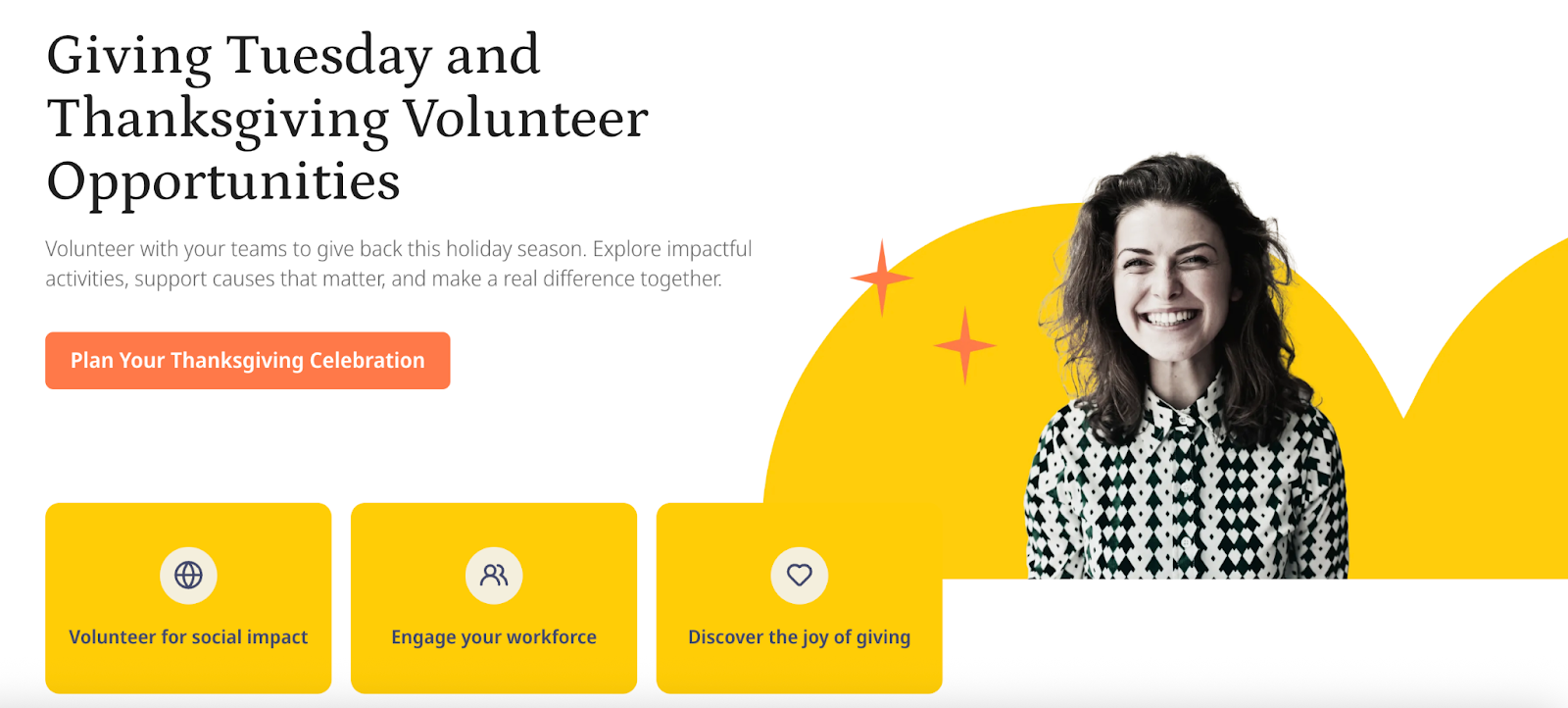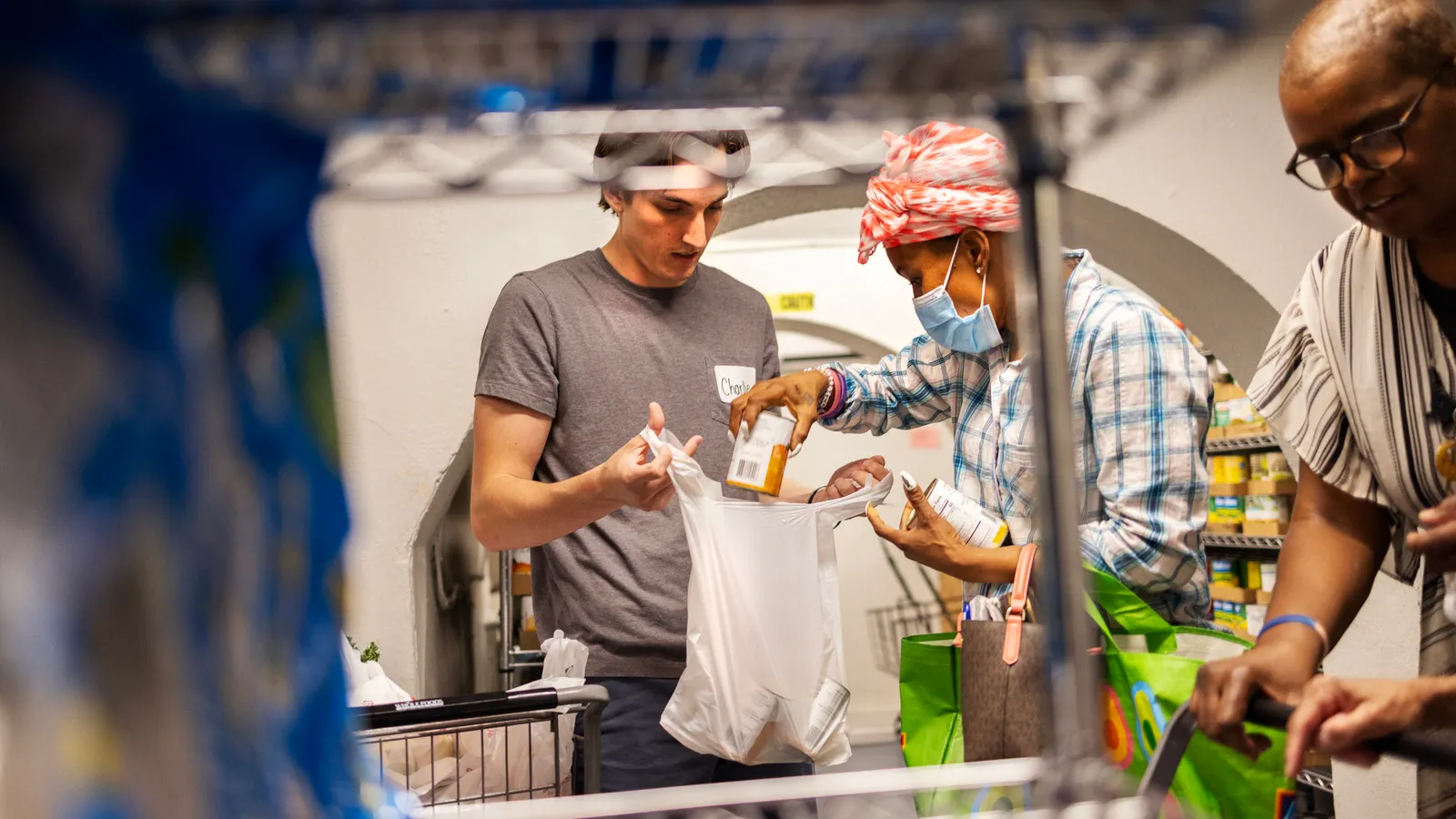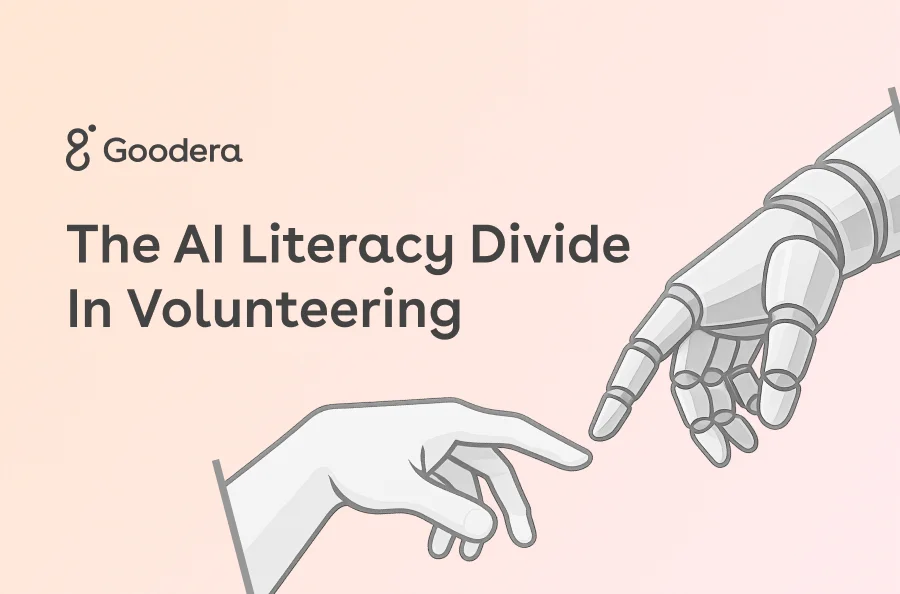Best Giving Tuesday Ideas to Celebrate with your Team
The holidays sparkle with lights, laughter, and lists, but somewhere between the celebrations and the sales, a quieter magic unfolds. It’s the moment when gratitude turns into generosity, and kindness finds its way into everyday life.
A team collecting donations for a shelter. Volunteers serving warm meals on a cold morning. Small acts, shared across countless hands, that define the true spirit of the season.
Giving Tuesday is where that spirit shines brightest. It carries the warmth of Thanksgiving forward, turning goodwill into action and reminding us that real change begins when we give together.
Also Read: Giving Tuesday 2025: Everything You Need To Know
Here are some thoughtful ideas for Giving Tuesday to help your organization celebrate with purpose and heart.
1. Launch a 24-Hour Matching Gift Challenge
A 24-hour matching gift challenge is one of the most engaging ways to celebrate Giving Tuesday. A matching gift means that a donor, often a company or major supporter, agrees to match every contribution made during the campaign, dollar for dollar, up to a set amount. This instantly doubles the impact of every gift, making giving feel even more powerful.
Why does it work so well? The time limit creates a sense of urgency, and knowing a gift will be matched makes giving feel even more meaningful. People respond to the chance to make a bigger impact in a short window, and seeing progress toward a goal motivates everyone to join in.

2. Create a Peer-to-Peer Fundraising Campaign
Peer-to-peer fundraising is a powerful way to expand your Giving Tuesday impact. Instead of relying solely on organizational appeals, you empower supporters to become ambassadors, creating personal fundraising pages and reaching their own networks. Every share, post, or message from a friend or family member carries more weight, making contributions more meaningful and personal.
This works so well because it taps into relationships and trust. People are more likely to give when they see someone they know championing a cause, and the ripple effect can grow your campaign far beyond your immediate audience. Providing supporters with email templates, social media graphics, and talking points makes it easy for them to share and inspire others. Recognizing top fundraisers or celebrating milestones keeps momentum high and participation enthusiastic.
3. Host a Virtual Giving Tuesday Event or Livestream
Virtual events are a fantastic way to celebrate Giving Tuesday because they bring supporters together no matter where they are. Livestreams let you tell your story in real time, showcase the impact of your programs, and offer multiple ways for viewers to engage throughout the day.
Here are some virtual volunteer activity ideas you can incorporate:
- Record festive greetings in sign language: Create inclusive messages for individuals with hearing loss.
- Design scratch cards for young coders: Engage your team in creating educational materials for aspiring programmers.
- Digital cleanup: Organize a session to declutter and organize digital spaces, promoting a cleaner digital environment.
Get in touch with us for 50+ impactful team volunteering ideas for Thanksgiving and Giving Teusday

These activities not only engage your team but also contribute positively to the community, aligning with the spirit of Giving Tuesday.
4. Design a Tiered Giving Menu with Specific Impact Statements
Tiered giving is a simple but powerful way to make Giving Tuesday donations feel tangible and achievable. By offering different giving levels tied to clear outcomes, donors know exactly how their contribution will help, making it easier for them to give.
You can structure your menu around meaningful impact, such as:
- $25 – Packs a mental health coping kit for a teen
- $50 – Creates a no-sew blanket for someone without housing
- $100 – Builds a bike for a teen in foster care
- $250 – Supports a team of volunteers in delivering holiday meals
When donors see the real-world impact of their gifts, they feel a stronger connection to your cause and are more likely to participate. Organizations like Feeding America have successfully used clear messaging like “$1 = 10 meals” to make giving concrete and boost contributions.
5. Organize a Food Donation or Meal Packing Drive
Food insecurity rises sharply around the holidays, making a food-focused initiative one of the most impactful ideas for Giving Tuesday. Teams can come together to pack meals, collect non-perishable items, or support local food banks with donations.

You can:
- Host a meal-packing event at your office or community center.
- Run a “fill a box” campaign where volunteers each contribute a few essentials.
- Support hunger relief nonprofits like Feeding America or local pantries.
Whether it’s in-person or virtual through digital donation drives, this activity turns generosity into nourishment for those who need it most.
6. Lead a Giving Tuesday Awareness Campaign
Sometimes the most powerful contribution is spreading awareness. A digital campaign that educates your audience about your cause can mobilize new donors, volunteers, and advocates.
Teams can:
- Share real impact stories across social channels.
- Launch a “Did You Know?” series on your website or LinkedIn.
- Encourage employees to post why they give using your campaign hashtag.
It’s an easy, high-visibility Giving Tuesday volunteering idea for companies that want to amplify reach and strengthen their mission’s voice.
Also Read: How to Build a Successful Giving Tuesday Campaign
7. Create Care Supply Packages for Communities in Need
Packing care kits is always one of the most engaging Giving Tuesday volunteer ideas. These can include hygiene essentials, stationery, or small gifts depending on the cause you support.
Try organizing:
- Hygiene kits for shelters or hospitals.
- Winter care packs with socks, gloves, and scarves.
- Education kits for children in underserved schools.
Volunteers can assemble kits on-site or participate remotely by ordering and shipping items to a central location.
8. Support an Environmental Cleanup or Tree Planting Drive
Green initiatives are a great fit for Giving Tuesday 2025, especially for teams focused on sustainability. You can collaborate with local environmental groups or organize your own drive.
Here are some campaign Ideas to inspire you:
- Hosting a local park or beach cleanup.
- Running a tree-planting challenge where teams aim for a specific goal.
- Organizing e-waste or recycling drives at the workplace.
These eco-friendly events let employees give back to the planet while building team spirit.
9. Launch an SMS or Text-to-Give Campaign
Not every act of giving needs a budget. Letter-writing campaigns are thoughtful Giving Tuesday volunteer activities that bring comfort and connection to isolated communities.
Participants can:
- Write holiday cards for seniors or veterans.
- Send encouraging notes to children in hospitals.
- Craft thank-you letters for healthcare workers or first responders.
These personal gestures create emotional impact and remind recipients that they’re not forgotten.
10. Run a Donation Drive for Warm Clothing or Essentials
Colder months make this one of the most timely Giving Tuesday ideas. You can coordinate clothing or blanket donation drives for local shelters or nonprofits supporting people experiencing homelessness.
Ways to engage:
- Set up drop-off bins at offices or community hubs.
- Create a “buy one, give one” challenge where each employee donates a winter essential.
- Partner with local NGOs to ensure collected items reach those who need them most.
Small contributions add up to big comfort for communities facing harsh weather.
11. Host a Virtual Volunteering Session
For hybrid and global teams, virtual Giving Tuesday volunteering creates an accessible way to participate from anywhere. Activities could include:
- Storytelling or mentorship sessions with youth organizations.
- Digital skill-sharing workshops for nonprofits.
- Online card-making for hospital patients or isolated seniors.
Virtual experiences let you expand reach, boost participation, and make impact without logistics barriers.
12. Organize a Community Art or Storytelling Project
Creative expression is a unique way to inspire generosity. Encourage volunteers to use art, writing, or photography to tell stories of hope, kindness, or change.
Ways to do this:
- Collaborate with local schools or art nonprofits.
- Host an internal art drive where employees donate handmade crafts or digital designs.
- Display collected artwork online or at your workplace to celebrate collective impact.
It’s a powerful reminder that Giving Tuesday is not just about money, it’s about sharing time, talent, and creativity for good.
How to Choose the Right Giving Tuesday Campaign for Your Organization
When it comes to Giving Tuesday ideas, there’s no one-size-fits-all approach. Every organization has its own strengths, audience, and capacity the key is to choose ideas that align with your mission and resources while inspiring your team to take action.
Here’s how to narrow it down:
- Start with your capacity: Be realistic about how much time, staff, and budget you can dedicate. A virtual volunteering event might be perfect if you have limited resources, while a meal-packing drive could work better for organizations with in-person teams.
- Know your audience: Think about how your supporters like to engage. Are they more responsive to emails, social media challenges, or text messages? Choose Giving Tuesday campaign ideas that meet them where they already are.
- Play to your strengths: Reflect on what’s worked well in past campaigns. If your employees love hands-on activities, plan something interactive like a care kit assembly. If storytelling drives donations, try a livestream or awareness campaign.
- Assess your resources: Do you have tools for online giving, live events, or tracking participation? Your tech stack can make or break execution. Platforms like Givebutter or Classy can simplify peer-to-peer fundraising or digital giving drives.
- Consider your timeline: Giving Tuesday 2025 may feel far off, but the best campaigns start early. Work backward from the big day to plan promotion, volunteer sign-ups, and partner coordination.
The most successful Giving Tuesday strategies usually blend a few complementary ideas instead of trying to do it all. For instance, pair a 24-hour matching gift challenge with a social media awareness campaign and a virtual volunteering activity. This mix balances reach, engagement, and impact, and keeps your team energized from start to finish.
Planning Timeline
To maximize success with your chosen Giving Tuesday ideas, follow this planning timeline:
10-12 weeks before (August):
- Form planning team and assign roles
- Review previous campaign performance
- Select 3-4 primary strategies from this list
- Set fundraising goal and success metrics
8-10 weeks before (September):
- Secure matching gift sponsors or business partners
- Begin content creation (videos, graphics, emails)
- Set up necessary technology platforms
- Recruit peer-to-peer fundraisers or ambassadors
6-8 weeks before (October):
- Launch "save the date" communications
- Complete and test donation pages
- Schedule social media content
- Brief the volunteers and staff on their roles
2-4 weeks before (November):
- Send first fundraising appeals
- Begin countdown email series
- Activate social media promotion
- Conduct final technology testing
Week of Giving Tuesday:
- Execute email sequence
- Post frequent social media updates
- Monitor real-time results and adjust messaging
- Celebrate milestones publicly
Week after:
- Send thank-you messages to all donors
- Create an impact report showing results
- Debrief with the team to identify improvements
- Begin year-end campaign planning
Common Mistakes to Avoid with Your Giving Tuesday Ideas
Even well-planned campaigns can stumble. Avoid these common pitfalls:
- Starting too late: Organizations that begin promoting Giving Tuesday on Monday night raise 60% less than those who build anticipation for weeks.
- Complicated donation process: Every extra click or required field reduces conversion rates by 15-20%.
- Ignoring mobile optimization: With over 60% of donations coming from mobile devices, a clunky mobile experience is campaign suicide.
- Forgetting to thank donors: Prompt, personalized acknowledgment increases the likelihood of future gifts by 40%.
- Not tracking results: You can't improve what you don't measure. Use UTM codes, track donation sources, and analyze performance data.
- Being too salesy: People give to causes they care about, not organizations that beg. Focus on impact and connection rather than desperate appeals.
After Giving Tuesday: How to Evaluate What Worked
Once your campaign is over, the real work begins; understanding what succeeded, what fell short, and how to improve for next year. Here’s a structured way to review your results and refine your Giving Tuesday strategy.
1. Financial Metrics
Start with the basics. These numbers reflect the overall success and efficiency of your campaign:
- Total dollars raised: Your headline number for impact and reporting.
- Number of donors (new vs. returning): Indicates reach, loyalty, and donor growth.
- Average gift size: Helps you assess donor capacity and giving behavior.
- Recurring donor conversion rate: Measures how many one-time givers opted for ongoing donations.
- Cost per dollar raised: Divide your total campaign expenses by total funds raised to evaluate efficiency.
2. Engagement and Digital Metrics
Track how well your audience interacted with your content and calls to action:
- Email open and click-through rates: gauge how effectively your messages resonated.
- Social media reach and engagement: track likes, comments, shares, and impressions.
- Website traffic and time-on-site: shows whether people explored your content.
- Video views and completion rates: a strong indicator of storytelling effectiveness.
- Peer-to-peer fundraiser participation: number of supporters who joined and raised funds.
3. Long-Term Impact Metrics
Beyond the day itself, these metrics reveal sustained outcomes:
- Donor retention rate at 90 days: Measures how many donors remain active post-campaign.
- Year-over-year Giving Tuesday growth: Compare performance to previous years.
- New donor acquisition cost: Total acquisition spend divided by the number of new donors.
- Lifetime value of Giving Tuesday donors: Predicts the total contribution expected over time.
4. How to Interpret and Act on Your Data
- Compare donor segments: Identify whether you reached new audiences or strengthened existing relationships.
- Look for drop-off points: Analyze where supporters stopped engaging (e.g., email click-through vs. completed donation).
- Cross-analyze metrics: High email clicks but low conversions may indicate issues with your donation page.
- Share learnings internally: Review results with your team and volunteers to align next steps.
- Plan your follow-up: Send personalized thank-you notes, share impact stories, and invite supporters to future events.
Evaluating these metrics will not only show how your Giving Tuesday campaign performed but also help you build a stronger, data-backed strategy for 2025, one that engages more donors and deepens long-term support.
Final Thoughts: Making Your Giving Tuesday Ideas Come to Life
Giving Tuesday represents an incredible opportunity to engage your community, raise critical funds, and advance your mission. The Giving Tuesday ideas outlined in this guide have been proven effective across thousands of organizations, from small local nonprofits to major international charities.
Remember that the most successful giving Tuesday campaign examples aren't necessarily the most expensive or complex, they're the ones that authentically connect with supporters, clearly communicate impact, and make giving easy and joyful.
As you plan your Giving Tuesday 2025 ideas, stay focused on what matters most: telling your story compellingly, making donors feel valued, and demonstrating the real-world change their generosity creates.
Start planning today, choose the Giving Tuesday ideas that align with your strengths and resources, and create a campaign that your supporters will remember and want to participate in year after year.

Frequently Asked Questions
1. When is Giving Tuesday 2025? Giving Tuesday 2025 will be on December 2, 2025. It always falls on the Tuesday following Thanksgiving in the United States.
2. What types of organizations can participate in Giving Tuesday? Any nonprofit, charity, school, community group, or social enterprise can participate. Giving Tuesday is open to all causes and sizes of organizations.
3. How much should we expect to raise on Giving Tuesday? Results vary widely based on organization size, preparation, and audience engagement. Small organizations might raise $1,000-$5,000, while mid-sized nonprofits often raise $10,000-$50,000, and large national organizations can raise millions.
4. Do we need special technology to run a Giving Tuesday campaign? Not necessarily. While specialized platforms help, you can run effective campaigns using basic email marketing software, social media, and a simple donation page on your website.
5. Should we offer matching gifts even if we don't have a major donor sponsor? Yes! You can create a matching pool from board members, combine several small matches, or even match gifts from organizational reserves if it will motivate additional donations.













